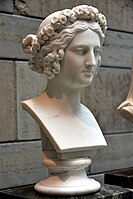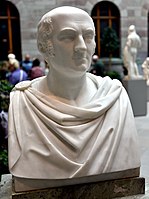Johan Niclas Byström
- Machine translation, like DeepL or Google Translate, is a useful starting point for translations, but translators must revise errors as necessary and confirm that the translation is accurate, rather than simply copy-pasting machine-translated text into the English Wikipedia.
- Do not translate text that appears unreliable or low-quality. If possible, verify the text with references provided in the foreign-language article.
- You must provide copyright attribution in the edit summary accompanying your translation by providing an interlanguage link to the source of your translation. A model attribution edit summary is
Content in this edit is translated from the existing Swedish Wikipedia article at [[:sv:Johan Niclas Byström]]; see its history for attribution. - You may also add the template
{{Translated|sv|Johan Niclas Byström}}to the talk page. - For more guidance, see Wikipedia:Translation.

Johan Niclas Byström (December 18, 1783 – 1848) was a Swedish sculptor.[1][2]
Byström was born at Filipstad and went to Stockholm at the age of twenty, studying there for three years under Johan Tobias Sergel. In 1809 he gained the prize of the Royal Academy of Arts, and in the following year visited Rome. He sent home a beautiful work, "The Reclining Bacchante," in half life size, which raised him at once to the first rank among Swedish sculptors.[3]
On his return to Stockholm in 1816, he presented the crown prince (the later king Charles XIV) with a colossal statue of himself,[4] and was entrusted with several important works. Although he was appointed professor of sculpture at the academy, he soon returned to Italy, and with the exception of the years from 1838 to 1844 continued to reside there. He died in Rome in 1848.[3]
Among Byström's numerous productions the best were his representations of the female form, such as Hebe, Pandora, Juno suckling Hercules (infra), and Girl Entering the Bath. His colossal statues of the Swedish kings were also much admired.[3]
Gallery
-
 Byström's seated statue of Linnaeus, Uppsala.
Byström's seated statue of Linnaeus, Uppsala. -
 Juno suckling the infant Hercules, Royal Palace, Stockholm
Juno suckling the infant Hercules, Royal Palace, Stockholm -
 Young woman with flowers wreath in her hair, by Johan Niklas Byström. Marble. Nationalmuseum, Stockholm, Sweden
Young woman with flowers wreath in her hair, by Johan Niklas Byström. Marble. Nationalmuseum, Stockholm, Sweden -
 Carl Johan Adlercreutz, count, officer, and statesman, by Johan Niklas Bystroms. Marble. Nationalmuseum, Stockholm, Sweden
Carl Johan Adlercreutz, count, officer, and statesman, by Johan Niklas Bystroms. Marble. Nationalmuseum, Stockholm, Sweden
References
- ^ Nyman, Thure (1934-01-01). "Byström i Stockholm". Konsthistorisk Tidskrift/Journal of Art History. 3 (1–4): 87–98. doi:10.1080/00233603408603177. ISSN 0023-3609.
- ^ Pettersson, Lennart (1998-01-01). "Johan Niklas Byström och Bengt Erland Fogelberg ‐ Samtidiga svenska skulptörer i Rom". Konsthistorisk Tidskrift/Journal of Art History. 67 (2): 93–114. doi:10.1080/00233609808604454. ISSN 0023-3609.
- ^ a b c Chisholm 1911.
- ^ Kent, Neil (2001). The Soul of the North: A Social, Architectural and Cultural History of the Nordic Countries, 1700-1940. Reaktion Books. pp. 284–285. ISBN 978-1-86189-067-2.
Attribution:
 This article incorporates text from a publication now in the public domain: Chisholm, Hugh, ed. (1911). "Byström, Johan Niklas". Encyclopædia Britannica. Vol. 4 (11th ed.). Cambridge University Press. p. 906.
This article incorporates text from a publication now in the public domain: Chisholm, Hugh, ed. (1911). "Byström, Johan Niklas". Encyclopædia Britannica. Vol. 4 (11th ed.). Cambridge University Press. p. 906.

- v
- t
- e
















